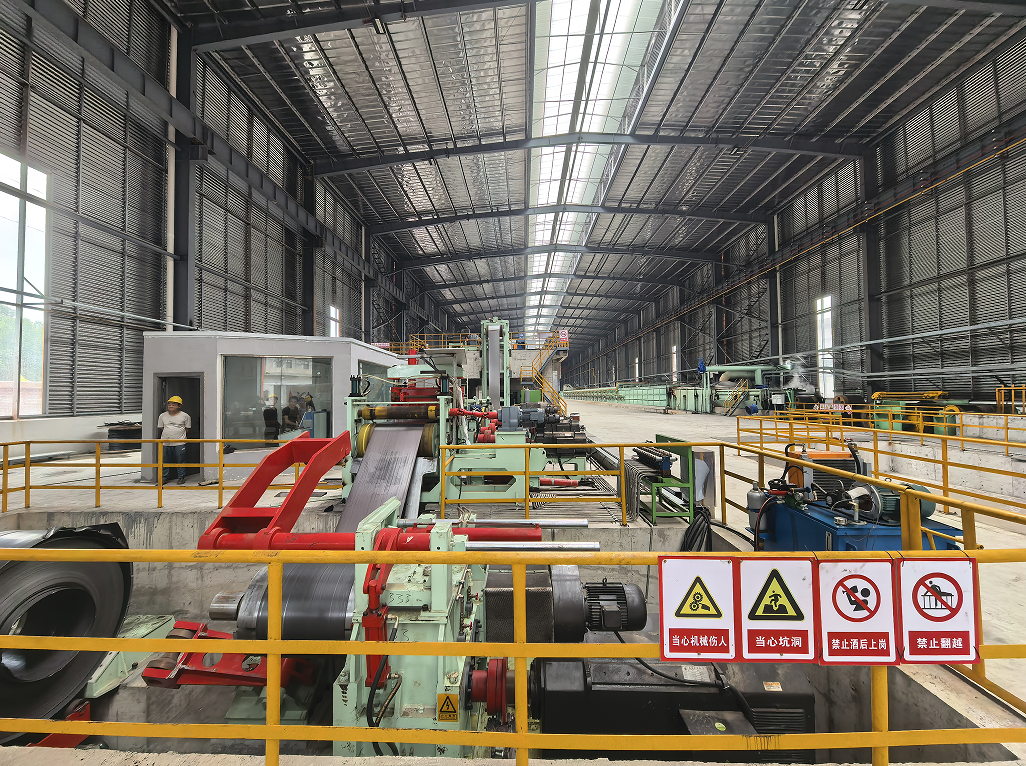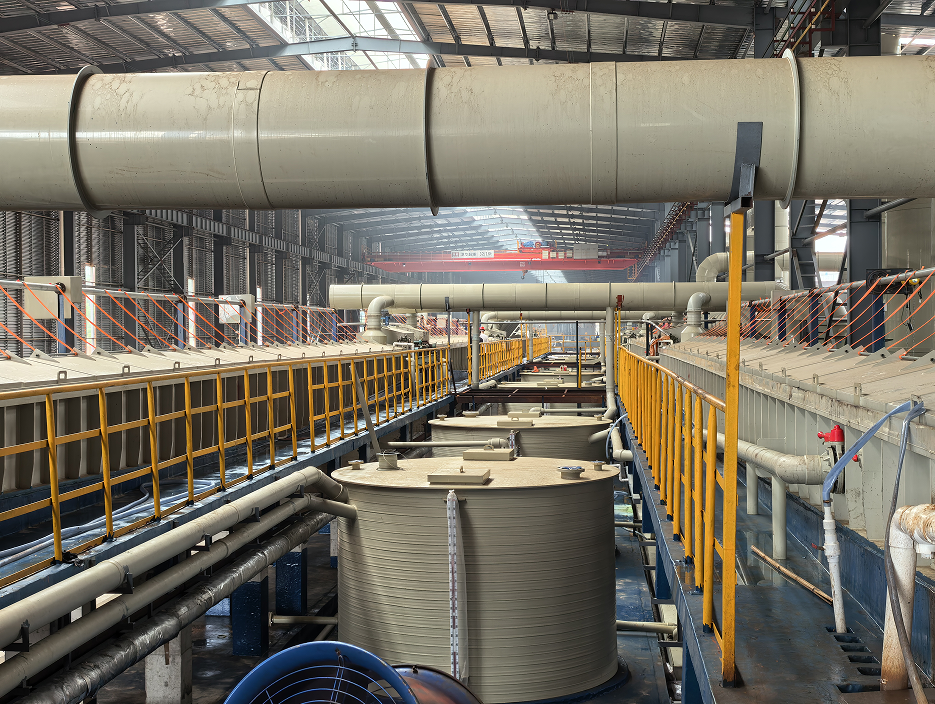What Is a Pickling Line and How Does It Work?
A Pickling Line is used to clean metal surfaces. This happens before the metal goes to the next step in making things. You see this process with carbon steel, stainless steel, and other special metals. The table below lists the main types of metals and their uses in different industries:
|
Metal Type |
Market Share Description |
|
Carbon Steel |
Has the biggest share of market demand. It is used a lot in building, cars, and roads. |
|
Stainless Steel |
Is a special type. It is chosen for jobs that need rust protection and a nice look. |
|
Others |
Includes special metals and mixes, like strong steels, aluminum, and copper mixes. |
Knowing how pickling works helps you understand why clean metal is important for making good products.
Key Takeaways
- A Pickling Line uses strong acids to clean metal. It uses acids like hydrochloric acid. This process takes away rust and dirt. The metal becomes smooth and ready to use.
- Pickling helps metal last longer. It stops rust from forming. Clean metal is needed for good products. Industries like cars and building need clean metal.
- The pickling process has many steps. First, workers load coils. Then, they clean the metal. Next, acid pickling happens. After that, the metal gets rinsed. Then, it is dried. Last, workers check the quality. Each step gets the metal ready for the next one.
- Safety is very important with pickling lines. Workers wear special gear to stay safe. They follow strict safety rules. This helps them handle acids safely. It also stops spills from happening.
- There are different kinds of pickling lines. Some are push-pull lines. Others are continuous lines. Each kind fits certain production needs. They balance flexibility and efficiency.

Pickling Line Overview
Definition
A Pickling Line is like a cleaning station for metal. In factories, it uses steps to clean metal surfaces. Steel coils go into the Pickling Line. The metal unwinds and moves through tanks with hydrochloric acid. The acid cleans the metal by taking off rust and dirt. This makes the steel smooth and ready for the next steps.
Purpose
Why do factories use a Pickling Line? The main reasons are:
- The process makes metal sheets smooth and clean. This helps when you need to paint or coat the metal.
- Pickled metal does not rust as fast. It lasts longer and needs less fixing.
- After pickling and annealing, the metal bends and shapes more easily. You can make more shapes and waste less metal.
Tip: Clean metal helps you avoid problems later. You get better products if you start with clean materials.
Position in Metal Production
The Pickling Line comes after hot rolling in steel making. At this stage, steel coils have dirt and oxides from heating. The Pickling Line takes off these layers. This makes the metal cleaner and stronger. It is important before cold rolling, coating, or cutting. Using a Pickling Line helps your steel meet high quality rules.
Pickling Line Process
Steps
You can follow a clear set of steps when you operate a Pickling Line. Each step helps you clean and prepare the metal for the next stage. Here is how the process works from start to finish:
- Material Loading: You load steel coils onto the entry coil car.
- Uncoiling: The coils unwind into a flat strip.
- Surface Cleaning: The strip passes through a cleaning section to remove loose dirt and oil.
- Acid Pickling Bath: The strip moves into an acid bath. The acid removes rust and oxides from the surface.
- Rinse Tanks: You rinse the strip in water tanks to wash away any leftover acid.
- Drying: The strip goes through dryers to remove moisture. This step helps prevent new rust from forming.
- Recoiling: The clean strip is wound back into a coil for easy handling.
- Quality Control: You check the coil to make sure it meets quality standards.
- Exit Coil Car: The finished coil is loaded for transport or further processing.
Note: The Pickling Line usually comes right after the hot mill section. It prepares the metal for cold rolling, coating, or cutting.
Chemical Reactions
The Pickling Line uses strong acids to clean the metal. These acids react with the rust and oxides on the surface. Here are some key points about the chemical reactions:
- Hydrochloric acid is the most common acid for steel pickling. It works fast and removes oxides well.
- Sulfuric acid was used more in the past because it costs less, but it is slower than hydrochloric acid.
- For special steels with more than 6% alloy, you need a two-step process. This uses acids like phosphoric, nitric, or hydrofluoric acid.
- These acids break down the rust and scale, leaving the metal surface clean and ready for the next step.
You might see different acids used for different metals. The goal is always to remove impurities and prepare the metal for further work.
Safety
Working with a Pickling Line means you must follow strict safety rules. Acids can be dangerous, so you need to protect yourself and the environment. Here are some important safety practices:
- Train all workers in spill response and first aid.
- Keep neutralizing agents, such as baking soda or lime, close by in case of spills.
- Store acids in special, ventilated areas away from anything that can catch fire.
- Use trays or barriers to catch leaks and prevent spills from spreading.
- Wear proper personal protective equipment (PPE), like gloves, goggles, and aprons.
- Collect and neutralize acid waste before you dispose of it.
- Hold regular safety training sessions on acid handling and emergency steps.
Many countries now have strict environmental rules for Pickling Line operations. For example, steelmakers in France and Singapore use eco-friendly methods to cut down on chemical waste and energy use. Companies that invest in green technology, like acid recycling systems, can meet these rules and help protect the environment.
Components
A Pickling Line has many parts that help clean metal. Each part does a special job. All the parts work together to make things safe and smooth.
Entry Section
The entry section gets metal ready for cleaning. Workers put steel coils onto the line. Machines weld coil ends together. This makes one long strip. The table below shows the steps:
Tip: Making a long strip keeps the process moving fast.
Acid Tanks
Acid tanks hold chemicals that clean the metal. Most lines use hydrochloric acid or sulfuric acid. The acid is strong, between 2% and 12.5%. Tanks must be tough to hold these acids. Some tanks last 5–7 years. Special tanks can last over 10 years.
- Hydrochloric acid bath tanks are used a lot.
- Sulfuric acid is also used sometimes.
- Acid strength is from 2% to 12.5%.
Note: Checking acid levels and tanks often keeps things safe.
Rinsing Units
Rinsing units wash off leftover chemicals after acid cleaning. This stops rust and keeps metal clean. Many lines use four rinse levels with reversed water flow. This method works fast and saves water.
- Rinsing takes away acids and salts so metal does not rust.
Drying Equipment
Drying equipment takes water off the metal surface. Hot air blowers or infrared heaters are used. Dry metal does not rust as fast. This step gets the coil ready for the next part.
Callout: Drying stops water spots and keeps metal looking nice.
Automation
Automation helps the Pickling Line work better and safer. Control systems run machines and keep things steady. Real-time monitoring finds problems early. Automation saves material and keeps workers safe from acids.
- Automation means fewer manual checks, so workers stay safe.
- AI helps use less acid and get better results.
Types of Pickling Line
When you look at how factories clean metal, you find two main types of Pickling Line. Each type works in a special way and helps you choose the best method for your needs.
Push-Pull
Push-pull pickling lines give you high flexibility. You can process different steel grades, thicknesses, and widths. This means you can handle many coil sizes, one after another. You do not need to wait for a large batch. You can switch from one type of metal to another quickly. This system works well if you want to produce smaller lots or change products often.
Tip: Push-pull lines help you save money when you start with a lower investment. You can add more features later as your needs grow.
You also get advanced automation and control systems. These features let you increase throughput capacity. You can make more products in less time.
The push-pull pickling line from Primetals Technologies shows how you can boost speed and keep flexibility. You can run different strip dimensions and steel grades without slowing down.
Continuous
Continuous pickling lines focus on efficiency. You feed coils into the line without stopping. The metal moves through the cleaning steps in a steady flow. This system works best when you need to process large volumes of metal. You get high productivity and consistent quality.
Factories use continuous lines for big projects. You can run the same type of steel for hours. This method helps you keep costs low and meet tight deadlines. You do not need to stop for coil changes as often.
Note: You should choose a Pickling Line based on your production goals. If you want to handle many types of metal, push-pull lines work best. If you need speed and volume, continuous lines are the top choice.

Benefits and Uses
Advantages
Using a Pickling Line gives you many good results. It takes away rust and dirt from metal. This makes the metal cleaner and stronger. You also stop problems that can happen later. The table below lists the main benefits:
You stop issues like too much scale, uneven cleaning, and rough surfaces. Doing regular checks and following each step helps keep your metal in great shape.
Tip: To stop strip breaks and over-pickling, always check your machines and watch the process closely.
Applications
Pickling Lines are used in many places. Each kind of line does a special job. Push-pull lines are good for different coil sizes and steel types. Semi-continuous and continuous lines work fast with big batches. Some lines are made for long or special-shaped products.
You see these lines in car, building, and airplane factories. Clean metal is needed for car bodies, building frames, and plane parts. Using a Pickling Line helps your products meet tough rules and last longer.
Alternatives
Mechanical Cleaning
You can choose mechanical cleaning when you want to avoid chemicals. This method uses physical force to remove rust, scale, and dirt from metal surfaces. Many factories use mechanical cleaning for safety and cost reasons. You see several options, each with its own benefits.
Tip: Mechanical cleaning helps you avoid chemical hazards and keeps your workplace safer.
Other Methods
You can find other ways to clean metal besides mechanical and acid pickling. Some new methods offer lower costs and better safety.
- Environment Friendly Safe Pickling (EFSP) systems cost less to build and run than traditional pickling lines. You need less space, and you can upgrade old systems with small changes.
- Pickling lines use chemicals, so you spend more on supplies and waste handling.
- Laser cleaning uses no chemicals. You get lower costs over time, especially when you clean large amounts of metal.
Note: You should look at your budget, safety needs, and production goals before you choose a cleaning method. New technologies like EFSP and laser cleaning help you save money and protect the environment.
You can mix different methods to get the best results for your factory. Mechanical cleaning works well for simple jobs. Advanced systems like EFSP and laser cleaning help you meet strict rules and lower your costs.
You have learned how pickling lines clean metal. These lines get metal ready for cars, buildings, and planes. Pickling lines use acids to take off rust and scale. The main acids are hydrochloric and sulfuric. Each acid has good and bad points:
Tip: Pick the best pickling method for your safety, cost, and quality needs. Try other ways if you want to use fewer chemicals.
FAQ
What is the main job of a pickling line?
A pickling line cleans metal by removing rust and dirt. You get smooth, shiny metal that is ready for painting or shaping.
Which acids do you use in pickling lines?
You use hydrochloric acid or sulfuric acid most of the time. Hydrochloric acid works fast. Sulfuric acid costs less but needs heating.
Is pickling safe for workers?
You must wear gloves, goggles, and aprons. Training helps you handle acids safely. Always keep neutralizing agents nearby.
Can you use pickling lines for all metals?
You use pickling lines mostly for steel. Some lines clean aluminum and copper. You need special acids for different metals.
How do you know if pickling worked?
You check the metal for a smooth, clean surface. Quality control teams look for rust, stains, or rough spots.

